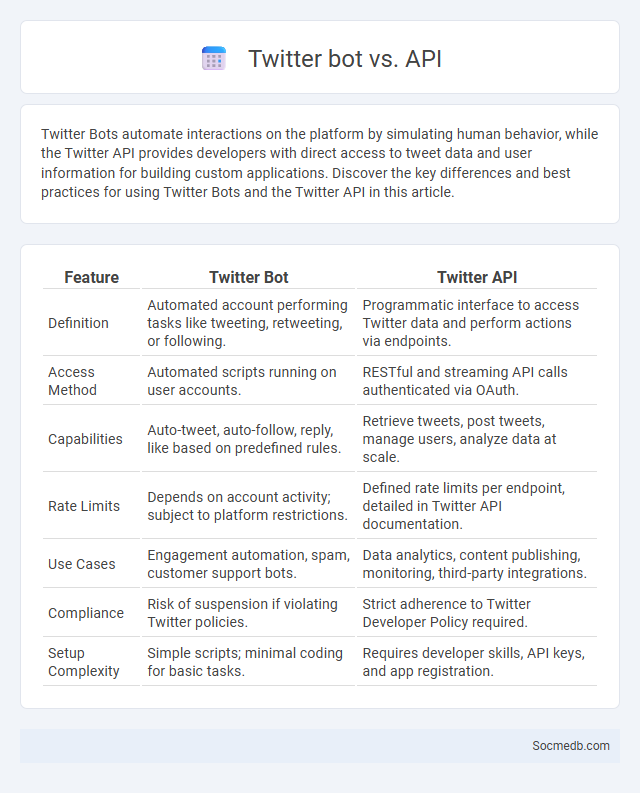
Photo illustration: Twitter Bot vs API
Twitter Bots automate interactions on the platform by simulating human behavior, while the Twitter API provides developers with direct access to tweet data and user information for building custom applications. Discover the key differences and best practices for using Twitter Bots and the Twitter API in this article.
Table of Comparison
| Feature | Twitter Bot | Twitter API |
|---|---|---|
| Definition | Automated account performing tasks like tweeting, retweeting, or following. | Programmatic interface to access Twitter data and perform actions via endpoints. |
| Access Method | Automated scripts running on user accounts. | RESTful and streaming API calls authenticated via OAuth. |
| Capabilities | Auto-tweet, auto-follow, reply, like based on predefined rules. | Retrieve tweets, post tweets, manage users, analyze data at scale. |
| Rate Limits | Depends on account activity; subject to platform restrictions. | Defined rate limits per endpoint, detailed in Twitter API documentation. |
| Use Cases | Engagement automation, spam, customer support bots. | Data analytics, content publishing, monitoring, third-party integrations. |
| Compliance | Risk of suspension if violating Twitter policies. | Strict adherence to Twitter Developer Policy required. |
| Setup Complexity | Simple scripts; minimal coding for basic tasks. | Requires developer skills, API keys, and app registration. |
Introduction to Twitter Automation
Twitter automation streamlines content scheduling, engagement, and analytics to boost your social media efficiency. By integrating tools like TweetDeck or Hootsuite, you can automate tweets, retweets, and responses, enhancing your online presence and saving time. Your brand benefits from consistent posting and data-driven insights, optimizing reach and interaction on Twitter.
What is a Twitter Bot?
A Twitter bot is an automated program designed to post tweets, retweet content, follow users, or interact with tweets based on predefined rules or artificial intelligence algorithms. These bots can amplify messages, manage customer service, or provide real-time updates, enhancing user engagement on the platform. You can leverage Twitter bots to streamline social media tasks and increase your account's activity efficiently.
Understanding Twitter API
Twitter API provides developers access to real-time tweet data, user profiles, and engagement metrics, facilitating analysis and integration into applications. It supports RESTful endpoints and streaming APIs for gathering tweets based on keywords, hashtags, or user IDs, enabling advanced social media monitoring and sentiment analysis. Proper authentication via OAuth 2.0 and adherence to rate limits are essential for effective and secure API usage.
Types of Bots on Twitter
Twitter hosts several types of bots including promotional bots that amplify marketing campaigns, spam bots that distribute unsolicited content, and automated news bots that share real-time updates. Engagement bots manipulate interactions by liking, retweeting, or replying to increase visibility artificially. Sentiment analysis bots monitor public opinion by analyzing tweet content for trends and emotional tone.
Twitter Bot vs. API: Key Differences
Twitter Bot operates as an automated account that interacts with users by posting tweets, retweeting, and responding based on predefined rules, while Twitter API provides developers with programmatic access to Twitter data and functionalities for custom application integration. Your choice between a Twitter Bot and the API depends on whether you need automated engagement or detailed data retrieval and manipulation capabilities. Understanding these key differences is essential for optimizing your social media strategy and achieving specific interaction or data analysis goals on Twitter.
Use Cases for Twitter Bots
Twitter bots automate content distribution, enabling brands to maintain consistent engagement by posting timely updates and responding to user inquiries efficiently. These bots analyze trending topics and user sentiment, allowing businesses to tailor marketing strategies and enhance customer support. Furthermore, Twitter bots facilitate event tracking and real-time news dissemination, improving audience reach and interaction.
Advantages of Using the Twitter API
The Twitter API provides comprehensive access to real-time data, enabling you to analyze trends, monitor brand mentions, and engage directly with your audience efficiently. Its robust functionality supports automated posting, customization of user experiences, and integration with other marketing tools to enhance your social media strategy. Leveraging the Twitter API helps boost your campaign performance through precise targeting and data-driven insights.
Security and Compliance Considerations
Social media platforms require stringent security measures such as multi-factor authentication and encryption to protect user data from breaches and unauthorized access. Your organization must adhere to compliance standards like GDPR, HIPAA, or CCPA to avoid legal penalties and maintain user trust. Regular audits and monitoring help ensure content and data management align with regulatory requirements while safeguarding privacy.
Choosing Between Twitter Bot and API
Choosing between a Twitter bot and Twitter API depends on your automation needs and technical skills. A Twitter bot offers a straightforward approach for automating tweets, replies, and follows using pre-set rules, ideal for marketers seeking quick engagement boosts. Leveraging the Twitter API provides greater flexibility and access to extensive features like data analytics, real-time monitoring, and custom integration, making it suitable for developers building advanced applications.
Future Trends in Twitter Automation
Twitter automation is rapidly evolving with advancements in AI-driven content generation, allowing more personalized and timely tweet scheduling to enhance engagement. Emerging trends include the integration of sentiment analysis tools to tailor interactions based on follower mood and behavior. Your social media strategy can leverage these innovations to optimize outreach and maintain a dynamic presence on the platform.
 socmedb.com
socmedb.com